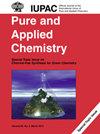Producing an antibacterial acrylic polyurethane coating with acylated mimosa tannins
IF 2
4区 化学
Q3 CHEMISTRY, MULTIDISCIPLINARY
引用次数: 0
Abstract
This work aims to fabricate the antibacterial coating with green biocide successfully. For this purpose, mimosa tannins were acylated with lauroyl chloride’s aid and pyridine’s support as a catalyst in the 1,4-dioxane, hexane and xylene solvents. Infrared analysis showed that mimosa tannins synthesized in the 1,4-dioxane were acylated better than in the other two solvents. FE-SEM analysis of the paint film showed that the acylated mimosa tannins at a content of 5 % dispersed quite well in the polymer matrix. The results of analyzing the mechanical properties of the paint film containing acylated mimosa tannins with contents ≤5 % show that the mechanical properties of the paint film are only slightly reduced compared to the mechanical properties of the pure coating, reaching the values: adhesion of size #1; abrasion resistance of 132.8 L/mil; impact strength of 170 kg cm and a relative hardness of 0.78. Antibacterial testing shows that the paint film containing 5 wt% acylated mimosa tannins have good antibacterial activity.用酰化含羞草单宁生产抗菌丙烯酸聚氨酯涂料
本研究旨在成功制备出具有绿色杀菌剂的抗菌涂层。为此,含羞草单宁以月桂酰氯为助剂,吡啶为催化剂,在 1,4-二氧六环、己烷和二甲苯溶剂中进行了酰化。红外分析表明,在 1,4-二氧六环中合成的含羞草单宁的酰化效果优于在其他两种溶剂中合成的含羞草单宁。漆膜的 FE-SEM 分析表明,含羞草单宁酸在聚合物基体中的分散性相当好,含量为 5%。对含酰化含羞草单宁含量≤5%的漆膜的机械性能进行分析的结果表明,漆膜的机械性能与纯涂料的机械性能相比只是略有降低,达到了以下数值:附着力为 1 号;耐磨性为 132.8 升/米;冲击强度为 170 千克厘米,相对硬度为 0.78。抗菌测试表明,含 5 wt%酰化含羞草单宁的漆膜具有良好的抗菌活性。
本文章由计算机程序翻译,如有差异,请以英文原文为准。
求助全文
约1分钟内获得全文
求助全文
来源期刊

Pure and Applied Chemistry
化学-化学综合
CiteScore
4.00
自引率
0.00%
发文量
60
审稿时长
3-8 weeks
期刊介绍:
Pure and Applied Chemistry is the official monthly Journal of IUPAC, with responsibility for publishing works arising from those international scientific events and projects that are sponsored and undertaken by the Union. The policy is to publish highly topical and credible works at the forefront of all aspects of pure and applied chemistry, and the attendant goal is to promote widespread acceptance of the Journal as an authoritative and indispensable holding in academic and institutional libraries.
 求助内容:
求助内容: 应助结果提醒方式:
应助结果提醒方式:


